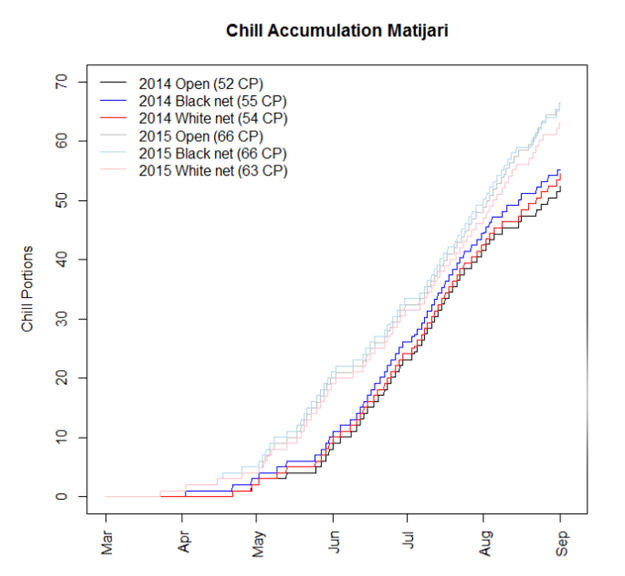Introduction
A netting demonstration site at Lyster’s Orchard, Manjimup, was set up to demonstrate the benefits of netting under Western Australian conditions. Two sections of 16mm cross over quad netting were installed over an established Cripps Pink and Fuji orchard to assess their effect on protection from birds, sun and hail damage. The demonstration established in November 2013 compared black net and white net to an area of non-netted (no net) trees within the same block in the orchard.
Specifications on the black net state a 23% reduction of both shade and UV radiation while white net stated a 20% reduction. To test the effect of the netting, sensors were installed in each section to continuously measure mid canopy air temperature, solar radiation, relative humidity and fruit surface temperature. A hand held meter was also used to measure photosynthetically active radiation during the season.
Winter chill accumulation and fruit quality were also measured together with observations of flowering to determine the dates of bud break, occurrence of first flower and full bloom.
Winter Chill
Winter chill was calculated from 1st March through until 31st August 2014 and 2015 from hourly temperature readings (Figure 1). There is no difference in chill accumulation under black net, white net or no net area. The nets do not reduce the amount of chill accumulated as there is minimal impact on the temperatures recorded under the black or white net or no net.
Figure 1. Chill accumulation under the black net, white net and no net in 2014 and 2015.
Flowering
Bud break and flowering data was collected from 10 trees under black, white and no net rows. Observations were made three times a week from 30 August 2014 to 30 October 2014. Whole tree assessments were made to determine the dates of bud break, occurrence of first flower and full bloom and to monitor progression of flowering. There is minimal difference in flowering progression between the netted trees to the no net trees. All trees still came into full bloom at the same time in 2014.
Fruit growth rate
Fruit diameter was measured 6 weeks after full bloom until the first pick. Little difference was measured in all sections during the majority of the season. In March, apples under the black net measured 3mm larger on average than fruit under white net or no net. However, at harvest time there was no significant difference in diameter of fruit grown under any of the treatments.
Minor variability in irrigation, tree management and nutrition are likely to have greater impact on fruit size than netting.
Mid canopy air temperature
There was minimal difference between the black and white net for mid canopy air temperature and humidity. Mean daily temperatures rarely varied more than 0.5 to 1 degree. The netting led to small increases in minimum temperatures and dampening of maximum temperatures. This action is similar to a cloud cover effect which reduces radiant heat loss overnight and reflects a portion of incoming daytime radiation reducing maximum temperatures.



